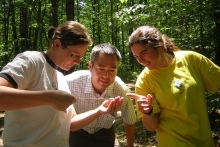You are here
Tracking Boston's 'Urban Metabolism'

Seventy percent of global carbon dioxide (CO2) emissions come from cities. As many cities rush to pursue new CO2 emissions goals, Harvard Forest collaborators at Boston University--Lucy Hutyra and Nathan Phillips--have developed an "urban metabolism" project to better understand CO2 in Boston and surrounding areas: where is carbon emitted? how is carbon stored? and what factors contribute to the net carbon balance?
Their measurements begin in Boston and end at the Harvard Forest. Nathan Phillips and his team measure atmospheric CO2 at set points along the way. Lucy Hutyra's team measures how plants behave differently in an urban versus a rural environment. Bullard Fellow Mark Friedl and his team use satellite imagery to track how the urban heat island affects seasonal changes.
Their effort involves more than 50 scientists, and many students (HF Summer Research Program student Leah Nagel pictured here). The work is funded by NSF, the LTER program, NASA, the Environmental Defense Fund, and IBM Smarter Cities.
- Watch the BU Today video:

